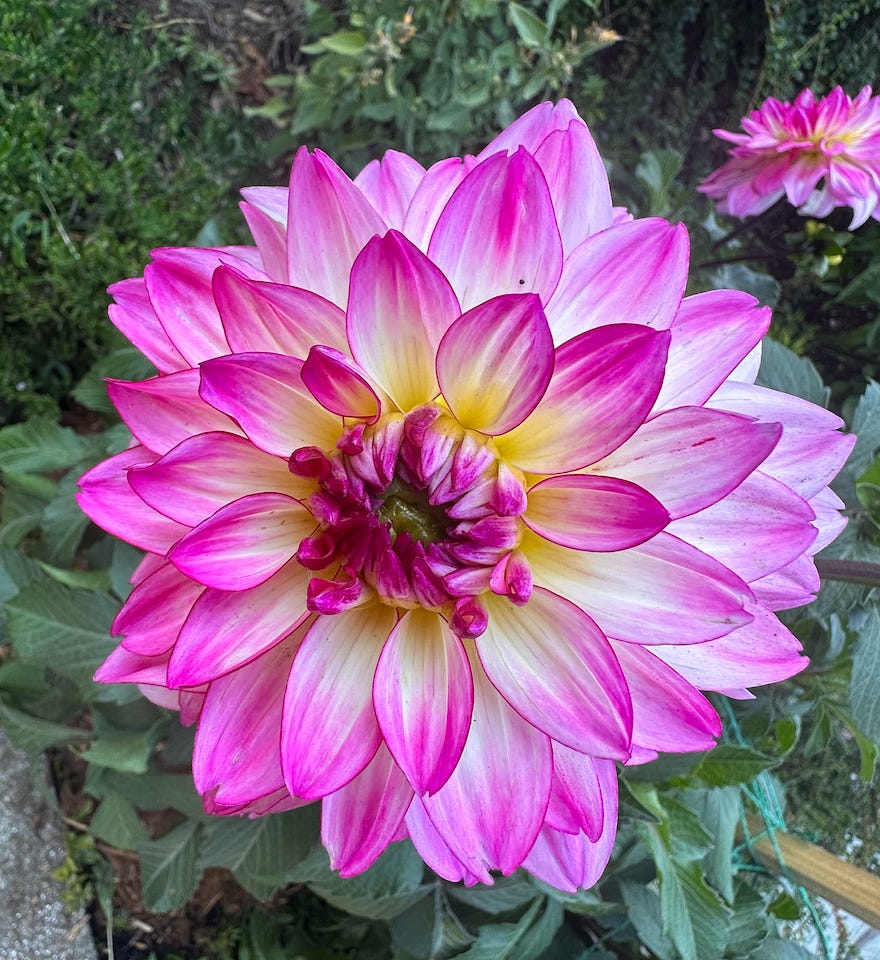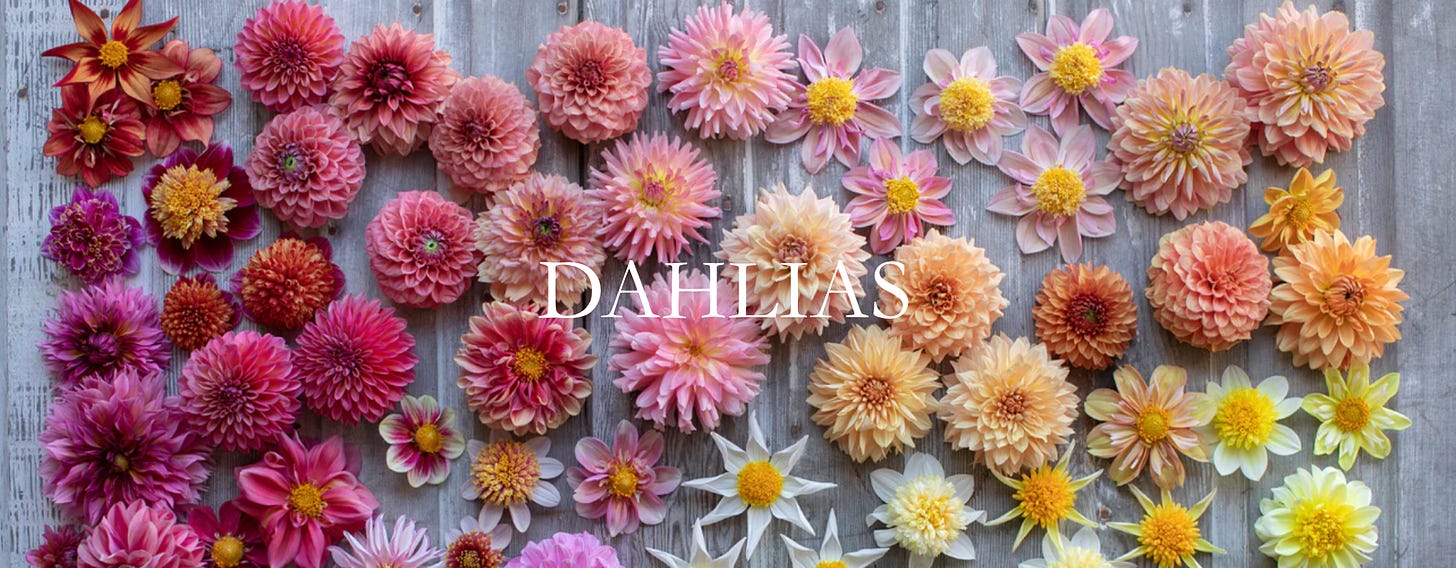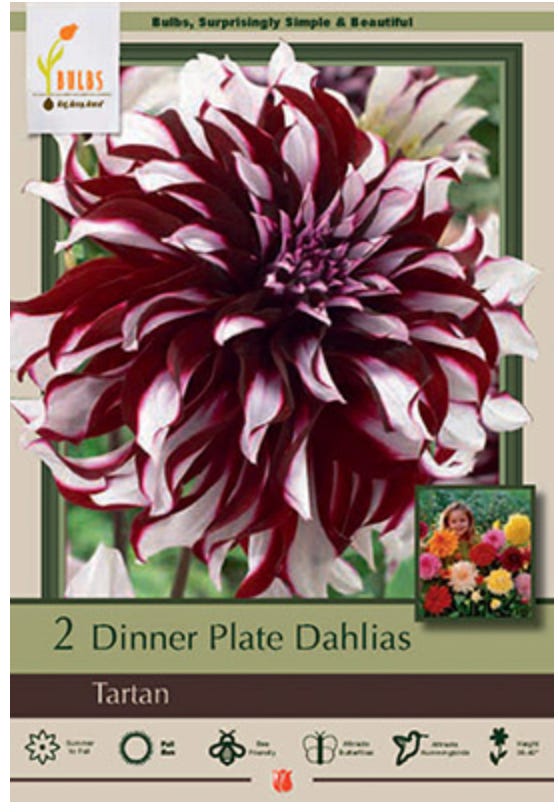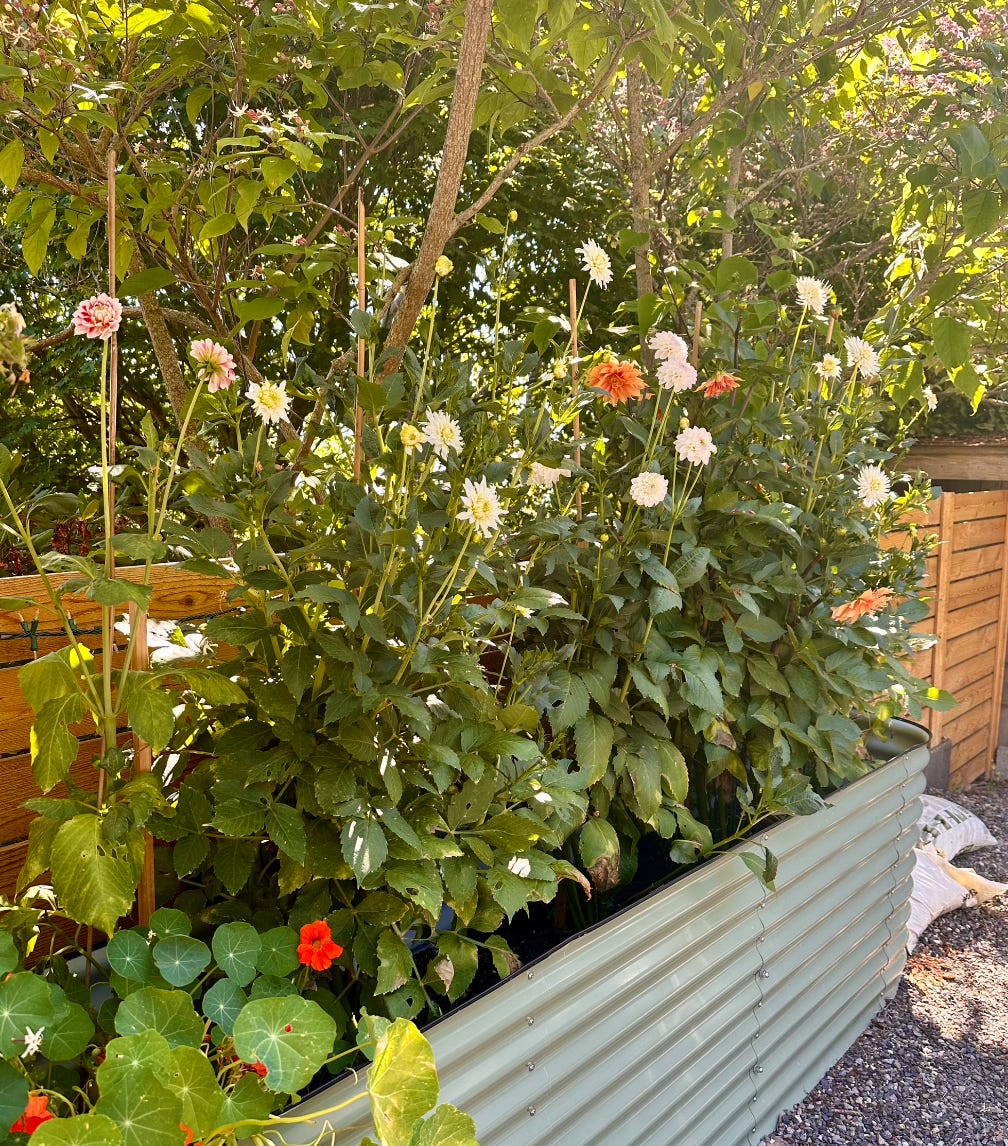And as always, if you know someone who’d like Garden Study, please forward this their way — but make sure to guide them to the specific way to *opt-in* to Garden Study emails, which you can find here.
You can grow dahlias in a lot of different places but few places are as obsessed with them as the Pacific Northwest. Our mild climate and extended growing season is perfect for this somewhat persnickety plant, which now comes in literally thousands of cultivars with more introduced each season. In many places in the area (depending on exposure) you can even leave the tubers in the ground over winter instead of digging them up, which makes growing them even easier.
Why dahlias? Well, like roses, there’s the sheer variety of kinds you can grow — but they’re also prized because they show up late in the season, when most flowers are already spent, and then they bloom pretty much constantly until your first frost. That’s a solid 2 months (if not more) of big flowers. Plus they make gorgeous and generally pretty long-lasting cut flowers, and they’re classic “cut-and-come agains,” meaning the more flowers you cut, the more it’ll produce. Magic, really.
You can grow dahlias from seed (hard!), from tubers you buy at the nursery, big box store, or online (usually much easier!) or buy plants from nurseries / Fred Meyer and transplant them. There are dahlias that grow just a foot tall and dahlias that grow up to six feet, with flowers that range from the size of golf ball to the size of a basketball. Some look like little pompoms, others like water lilies, the true behemoths are called “dinner plates” for obvious reasons. You can get a good sense of types at the Floret Dahlia Library, which is pretty magestic.
Some people credit Floret (and lead farmer Erin Benzakein) for sparking the current wave of the dahlia craze, and I think that’s right — she bred and selected dahlias of a palette and overall vibe very much in line with millennial aesthetics. But most people who’ve been watching these sorts of things for awhile trace the modern popularity of the flower to Martha Stewart, who helped transform it from a flower largely grown for show and competition into a flower garden staple.
I’ve grown dahlias the last three years. The first two summers, I bought plants at the nursery and transplanted them into pots with significant drainage on my deck. The first year, this strategy worked fine. The second year, the plants turned out mediocre at best. So this year, I decided to try planting tubers. I’d read the basics in Floret’s Discovering Dahlias, so I bought four tubers from my local farm and then impulse bought four of those plastic bag packets from a company called Netherland Bulbs at the nursery (two for one, what a steal, or so I thought).
I planted the tubers a few weeks before our last frost date, which was late April. Half went in the same six pots on my deck, and half went in some new super-raised beds I’d invested in from VegoGarden for a sunny spot up at entry way to my house. Several of the tubers had already begun to sprout indoors (which is good!) so I knew most would be viable, but I was still convinced the other half would just poop out. I decided that I’d keep one VegoGarden bed for transplants and see how that went — and then buy a few replacement tubers with a birthday gift certificate from Triple Wren Farms (a local dahlia farm).
If you know a lot about dahlias, this is the point where a few red flags may be waving — and we’ll get to those soon. But first I’ll say that all but one of the tubers sprout, and when I put my Triple Wren dahlias in some old barrels, they too sprouted (even if they took longer). So right now I have a total of 20 dahlias of various provenances growing in different places in my garden — and all of them have very different fates. So here’s what this novice has learned — both through my own experience and by going REALLY DEEP in the Dahlia Growers Facebook Page.
1) Where You Buy Absolutely Matters
This is not like tulips, where you’ll probably get a solid tulip no matter if you buy your bag from Costco or some fancy online place. The big distinction in the dahlia world is between small growers and “importers,” who are importing their tubers from huge farms overseas (usually in the Netherlands). Importers include: Netherland Bulb Company (which supplies the tubers in the little plastic bags that you get a lot of local nurseries, Wal-Mart, Home Depot, etc.), Eden Brothers, Burpees, basically any big online place where you get seeds and plants — they’re importing in bulk.
The main problem with these importers is quality control. They’re harvesting and sorting tubers by machine. Tubers often arrive with gall (which means you have to throw them out entirely), are the wrong tuber, have no active eyes, OR are the “right” tuber but the cultivar DNA has been degraded, which means that they’re reverting back to whatever they looked like before they were bred (and often have what’s called a ‘blown eye,’ or yellow center, when they’re not supposed to). To give you an idea of what I’m talking about, here’s what I thought I was buying:
And here’s what’s blooming:
Now, is this flower THE WORST? No, of course not. It’s just not what I bought or what I want. Many of these companies will refund you if you prove that your tuber has arrived with gall or won’t sprout, but it’s often too late to salvage the season.
So where should you buy? The Dahlia Facebook group (and Dahlia Addicts, a site that recommends places to buy every varietal) say that American Meadows is a pretty decent importer. But the general consensus is that if you want a particular type of dahlia and you want a much higher chance of it being healthy, you should order from smaller flower farms (or, even better, swap with local friends/gardeners — if you’re in an area that can grow dahlias, there will almost certainly be a Dahlia association in the general area, and people love to swap by mail).
The biggest small farm that gets the most praise = Swan Island Farms, which is located just outside of Portland (you can also buy tubers there starting now, which is nice for those of us weirdos already thinking about your Summer 2024 garden). This year I’m also ordering from Summer Dreams, which is out of Michigan and gets praise from the FB group, and probably a few from Chelan Butte.
Triple Wren has some of the most coveted varieties and is also a big more expensive — and I’ve heard mixed things about their tubers viability. FWIW, all three of mine sprouted and are doing wonderfully. Swan Island is open now but the rest generally open up ordering sometime between September and the early winter — get on their mailing lists if you want to be notified when they’re about to start. (Of course, if you have other places you like to source, please share in the comments…..I also think we should consider a Garden Study tuber swap if there’s enough interest????)
2.) It’s the Soil Stupid
Truly how many times do I need to learn this lesson — if you don’t amend the soil in some way (even in pots!) your plant is not going to thrive like you want it to (unless you’re planting pretty much directly into horse manure, which I know some people do and wow their dahlias are ridiculous).
The containers where I buried my first tubers hadn’t been amended in any way — in fact, most of the potting soil was, at that point, nearly three years old. Sure I put a few more inches of soil on top, but guess what, old potting soil gets all the nutrients sucked out of it (and is often SUPER dry). All of the tubers came up fine, but as soon as they started blooming, the leaves started going into crisis. It wasn’t spider mites (we’ll talk about that soon) it was just….shit soil. A friend suggested I layer 2 inches of compost on the top of the pot and fertilized (more on that soon too). Six weeks later, they’re doing much better — but I put a lot of stress on them by not having the soil right in the beginning, and several of the plants are much smaller (and producing far fewer flowers) than they should be.
So what will I do next year? For pots, a mix of entirely new potting soil, compost, and ‘sterile’ steer manure. For beds, mix in the same.
3.) Dahlias are Hungry
Dahlias are so-called “heavy feeders” which means they want some additional plant food high in nitrogen. I had just been using Miracle-Gro Bloom Boost every other week, which is fine, but I was re-reading Floret’s Discovering Dahlias and Erin noted that she does a fish or kelp fertilizer as the plants mature. I tried it out and….wow. It’s like giving your plants the best TikTok filter, or a new shampoo that makes their hair shine like a supermodel’s.
It stinks to high heaven, but the stink usually goes away after a day (just don’t let your dog get a whiff). Next year I’m going to collect a bunch of seaweed from the beach and make a homemade (and much cheaper) seaweed “tea” in a garbage can. That’s going to stink. (I’ve been using this fish fertilizer but you can get other kinds pretty much everywhere)
Another tip from the FB Group I’m trying out: if your plants are slow to bloom, give them a hefty scoop of epsom salt to give them a kick in the pants. Stay tuned.
4.) Pinching Really Does Matter
When a dahlia sprouts from a tuber, it usually sends up a main stem and everything branches from there. If you snip off (“pinch”) that main stem when it has ~three sets of leaves, you encourage the plant to grow a bunch of main stems instead of just one, which means you get a bushier plant and a lot more booms.
Because I’d never grown dahlias from tubers before, my transplants had always come pre-pinched. I pinched all of my tubers save one, which had two main sprouts….and I figured that was fine? Nope, should’ve pinched both of them, it’s far less bushy than my other plants.
Compare to the dahlias in my VegoGarden container, all of which had been pinched:
[Note that these are all the Netherland Bulb company and one of out of five is what was promised]
5.) So Many Bugs, So Many Diseases
The buds on one of my plants started to get brown and nibbly; the leaves started to curl. The problem? Spidermites. Invisible little guys. You can counteract by cutting off sickly parts, giving regular sprays with water, using Neem or Insecticidal Soap….but you can also be more mindful than I was and give your plants a good Neem spray every week even before they start showing signs. (Neem is an organic oil, not toxic, and not expensive).
People also sing the praises of beneficial insects, which I haven’t tried but would love to hear more about if you have.
There’s also powdery mildew, which is a problem when there’s too much rain or moisture and looks like fine white powder on your leaves (best advice = once your plant starts budding up/flowering, strip the first foot of the plant of leaves so as to create better air circulation down below). Last year I successfully fought an early case of powdery mildew but meticulously cutting off the diseased leaves and a daily Neem spray for a week.
And finally there’s Dahlia Mosaic Virus, often referred to as “virus.” You can learn more about it here, and it’s the subject of intense discussion on the Facebook page, in part because, well, pretty much every dahlia has it, it’s just a matter of whether it’s dormant or active. (80-90% of dahlia tubers and plants test positive). Once a dahlia has the disease, so to does its tubers, so you can see how it spreads very easily when there’s no tuber quality control. The disease can also spread from one plant to nearby plants via bugs, so some people advise destroying a plant as soon as it shows signs of mosaic.
My understanding is that dormant virus is often activated through plant stress — and the irregular summer weather (extreme heat, extreme rains) in many places in the U.S. has led to a whole bunch of activated virus. Right now one of my Netherland tubers seems to have it, but I’m doing what some advise in the group: isolate the pot from other dahlias, strip it of all affected leaves, fertilize, and see if it recovers. The thinking: if (neary) all dahlias have it, it’s not worth trashing the plant.
If you were selling tubers, you wouldn’t do this, and I promise I won’t put these tubers in the Dahlia Exchange, but it’s an interesting philosophical discussion (that, at least in the FB group, also leads to discussion about whether disease eradication is possible or necessary, if there’s just more awareness now because of groups like these diagnosing, etc. etc.)
6.) Dahlias are Ridiculously Addictive
Is the sheer variety? The demonstrative beauty of the blooms? The sheer number of blooms? (For the first time in my life, I’m a person with 3-4 bouquets in my house at all times). Growing new cultivars, trading tubers, seeking out ‘unicorns,’ all of it feels a lot like the pleasures of collecting Pokemon cards (or, for us olds, baseball cards….or My Little Ponies). The fact that each plant usually creates 3-5 viable tubers makes the trading aspect all the more viable.
I already have a super nerdy spreadsheet of the tubers I want to buy or trade for and I’m thinking of other places I want to tuck them into the existing garden. I want to grow enough to have a little stand in the front of my house where I can give away blooms. I’ve screwed up in so many ways, and yet I’m so excited to screw up in new and exciting ways next year with even more dahlias.









